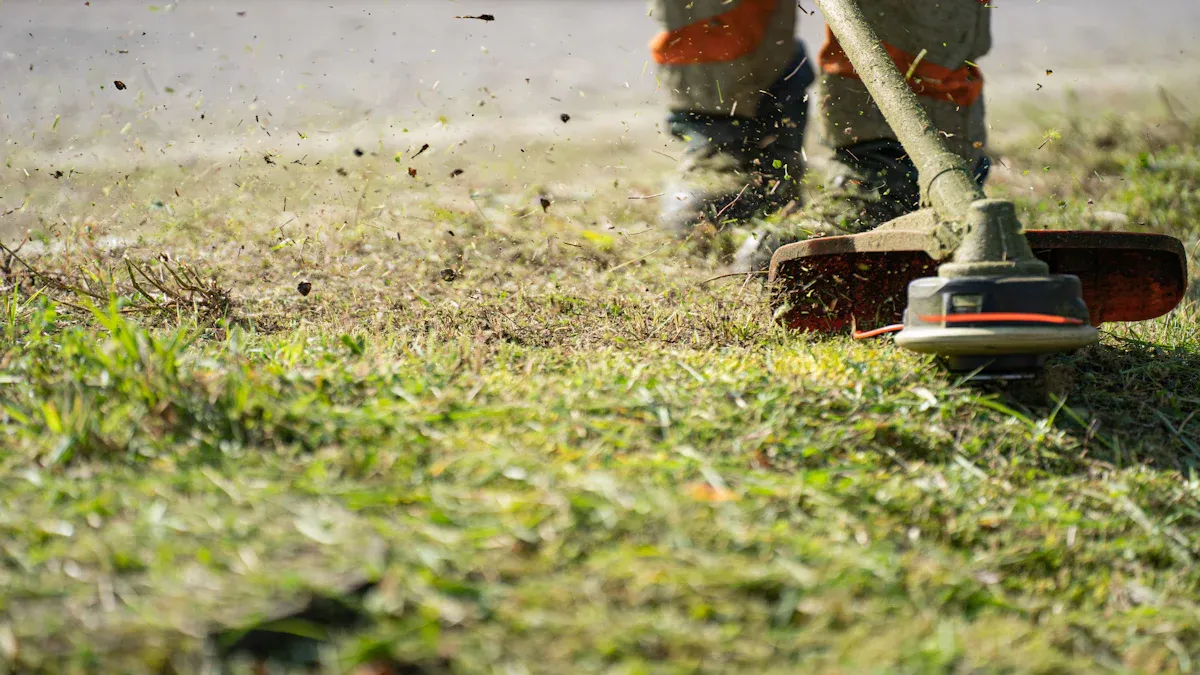Choosing the right trimmer line matters. It impacts how well your trimmer works and how efficiently you can tackle your yard. Factors like diameter, shape, and material play a big role in performance. By understanding these elements, you’ll make smarter choices that keep your lawn looking its best.
Key Takeaways
- Choose the right diameter for your trimmer line. Thicker lines handle tough jobs, while thinner lines are better for light tasks.
- Select the appropriate shape of trimmer line. Round lines are for general use, square lines cut tougher vegetation, and multi-sided lines offer versatility.
- Consider the material of the trimmer line. Nylon is popular for its balance of strength and flexibility, while copolymer offers extra durability.
Trimmer Line Diameter
Importance of Trimmer Line Diameter
When it comes to choosing the right trimmer line, diameter is a key factor. The diameter affects how well your trimmer performs. A thicker line can handle tougher jobs, like cutting through dense weeds or thick grass. On the other hand, a thinner line works better for lighter tasks, such as trimming around flower beds or sidewalks.
Using the right diameter helps you achieve a clean cut without straining your trimmer. If you pick a line that’s too thick, it can bog down your machine. Conversely, a line that’s too thin may break easily or not cut effectively. So, understanding the diameter is crucial for getting the best results in your yard work.
Common Trimmer Line Diameters
Trimmer lines come in various diameters, typically ranging from 0.065 inches to 0.155 inches. Here’s a quick breakdown of common sizes and their uses:
- 0.065 inches: Ideal for light-duty tasks. Perfect for small yards and delicate trimming.
- 0.080 inches: A versatile choice for medium-duty jobs. Great for regular grass and weeds.
- 0.095 inches: This size works well for most residential tasks. It balances strength and flexibility.
- 0.105 inches and above: Best for heavy-duty work. Use this for thick brush and tough weeds.
Choosing the right diameter ensures that your trimmer line matches the job at hand. Always check your trimmer’s manual for recommendations on the best diameter for your specific model. This way, you can avoid any mishaps and keep your yard looking sharp!
Trimmer Line Shape
When choosing a trimmer line, the shape matters just as much as the diameter. You have three main options: round, square, and multi-sided. Each shape offers unique benefits that can affect your trimming experience.
Round vs. Square vs. Multi-Sided Trimmer Line
- Round Trimmer Line: This is the most common type. It’s great for general trimming tasks. The smooth surface allows for easy cutting through grass and light weeds.
- Square Trimmer Line: This shape has sharp edges, which helps it cut through tougher vegetation more efficiently. If you’re dealing with thick weeds or brush, square line can save you time and effort.
- Multi-Sided Trimmer Line: This line combines the benefits of both round and square shapes. It features multiple cutting edges, making it effective for various tasks. You can tackle everything from light trimming to heavy-duty jobs without switching lines.
Impact of Trimmer Line Shape on Efficiency
The shape of your trimmer line directly impacts how efficiently you can work. For instance, if you use a round line for heavy brush, you might find yourself struggling. On the flip side, using a square line for light grass can lead to unnecessary wear and tear.
Choosing the right shape helps you maximize your trimmer’s performance. You’ll finish your tasks faster and with less effort. So, consider your yard’s needs and select a trimmer line shape that matches the job!
Trimmer Line Material
Nylon vs. Other Trimmer Line Materials
When it comes to trimmer line materials, nylon is the most popular choice. It offers a great balance of strength and flexibility. You’ll find that nylon trimmer lines can handle various tasks, from light trimming to tougher jobs. But did you know there are other materials available too? Let’s take a look at some alternatives:
- Copolymer: This material is a blend of different types of nylon. It provides extra durability and resistance to wear. If you want a line that lasts longer, copolymer might be the way to go.
- String Trimmer Line: Some lines use a mix of nylon and other materials, like plastic. These lines can be lightweight and easy to handle, but they may not be as durable as pure nylon options.
- Metal Wire: For heavy-duty tasks, some people opt for metal wire. While it can cut through thick brush, it’s not suitable for all trimmers. Plus, it can damage your equipment if you’re not careful.
Choosing the right material depends on your specific needs. If you’re looking for versatility and reliability, nylon is a solid choice. However, if you often tackle tough jobs, consider trying copolymer or even metal wire.
Durability of Trimmer Line
Durability is a crucial factor when selecting a trimmer line. You want a line that can withstand the rigors of yard work without breaking or wearing out too quickly. Here are some points to consider:
- Resistance to Fraying: A durable trimmer line resists fraying and breaking. Look for lines that advertise this feature, as it can save you time and money in the long run.
- Weather Resistance: Your trimmer line should hold up against various weather conditions. UV rays from the sun can weaken some materials over time. Choosing a line designed to resist these effects can extend its lifespan.
- Thickness Matters: Thicker lines generally offer more durability. If you frequently trim tough weeds or brush, opt for a thicker diameter. This choice helps prevent breakage during heavy use.
Trimmer Line Cost Considerations
Budgeting for Trimmer Line
When it comes to buying trimmer line, budgeting is key. You want to find a line that fits your needs without breaking the bank. Start by determining how often you’ll use your trimmer. If you trim your yard regularly, investing in a higher-quality line might save you money in the long run.
Here are some tips for budgeting:
- Estimate Usage: Think about how much trimming you do. More frequent use means you’ll need to buy more line.
- Compare Prices: Check different stores and online retailers. Prices can vary, so take your time to find the best deal.
- Buy in Bulk: If you find a line you like, consider buying in bulk. This option often saves you money per unit.
Value vs. Price in Trimmer Line Selection
You might wonder whether to choose a cheaper trimmer line or invest in a more expensive option. Remember, price doesn’t always equal quality. A lower-priced line may seem appealing, but it could wear out quickly, costing you more in the long run.
Ask yourself these questions:
- What’s the purpose? If you only need it for light trimming, a budget option might work. For tougher jobs, spend a little more for durability.
- How often will you replace it? If you find yourself replacing a cheap line often, it might be worth it to invest in a better one.
Finding the right balance between value and price will help you make a smart choice for your yard care needs.
Implications of Using the Wrong Trimmer Line
Damage from Incorrect Trimmer Line
Using the wrong trimmer line can lead to serious damage. If you choose a line that’s too thick for your trimmer, it can strain the motor. This strain might cause overheating or even burn out the engine. On the flip side, a line that’s too thin may snap easily. When this happens, you could end up with pieces flying around, which can be dangerous.
Tip: Always check your trimmer’s manual for the recommended line specifications. This simple step can save you from costly repairs!
Inefficiency with Wrong Trimmer Line
Inefficiency is another major issue when you use the wrong trimmer line. If you pick a line that doesn’t match your trimming needs, you’ll find yourself working harder for less result. For example, using a round line on thick weeds means you’ll spend more time and effort. You might have to go over the same area multiple times, wasting both energy and time.
Instead, using the right trimmer line allows you to cut through grass and weeds smoothly. You’ll finish your tasks faster and enjoy a well-kept yard without the hassle. So, take the time to choose wisely!
Choosing the right trimmer line makes a big difference in your yard work. Remember to consider diameter, shape, and material. By making informed decisions, you’ll enjoy better results and a healthier lawn. So, take your time, pick wisely, and watch your yard thrive!
Post time: Sep-30-2025









